The most high-profile match in Ligue 1 this past weekend saw FC Nantes square off against Lille at the Stade de la Beaujoire. Entering the match, Lille were in excellent form having won four out of their last five matches in the league. In contrast, Nantes were experiencing a dip in form, as they had won just once in the league since mid-January. Nevertheless, with qualification to the Champions League awarded to the top three teams from Ligue 1, a win for either side would take them within striking distance of third-placed Stade Rennais and reignite their hopes of earning a spot in European football’s elite club competition.
The game began at an exceptionally fast pace with Lille setting the tempo through quick and aggressive transitions both offensively and defensively. Lille would continue to boss the game for the majority of the first half, although the score at halftime remained 0-0.
The second half started similarly to the first, with Lille dominating the early exchanges. Their supremacy was finally rewarded in the 58th when minute Benjamin André scored off a corner kick. Over the final half-hour, the tempo slowed, and the match became more even. Despite this, Nantes failed to break down the Lille defence, and the match ended 1-0.
This tactical analysis will examine the tactics of Lille and Nantes and provide analysis as to why Lille were deserved winners.
Lineups
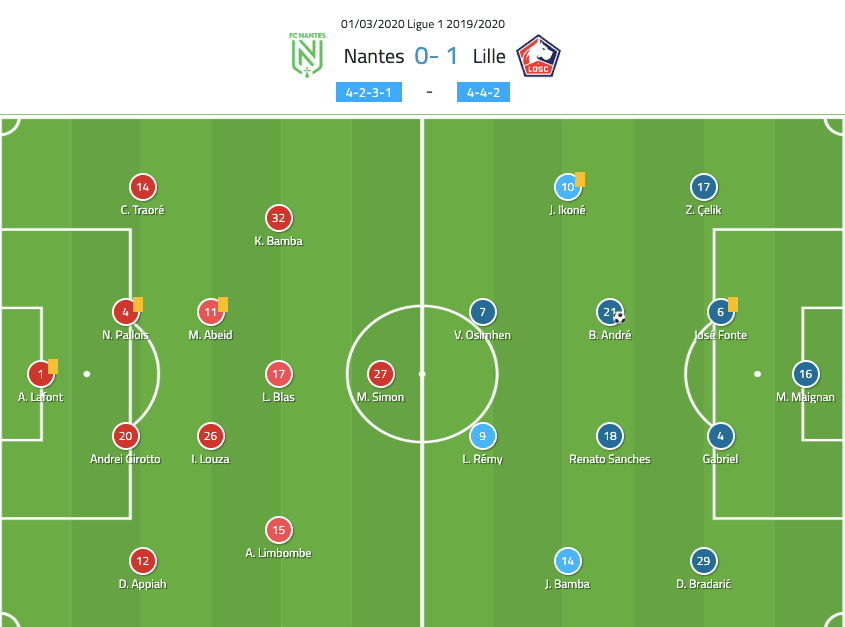
To begin the match, Nantes opted for a 4-2-3-1 formation. In defence, Christian Courcuff selected his preferred back four in Charles Traoré, Nicolas Pallois, Andrei Girotto, and Dennis Appiah. Ahead of the backline acting as a double pivot were Mehdi Abeid and Imran Louza, while Ludovic Blas played attacking mid with Kader Bamba to his left and Anthony Limbombe to his right. Leading the line as a lone striker was the pacey Moses Simon.
Lille preferred to start the match in a 4-4-2 formation. Gabriel and José Fonte formed the centre back pairing, while Domagoj Bradarić and Zeki Çelik were stationed at left and right-back respectively. In midfield from left to right were Jonathan Bamba, Renato Sanches, Benjamin André, and the dynamic Jonathan Ikoné. Finally, spearheading the attack was the striker partnership of Victor Osimhen and Loïc Rémy.
Lille’s fast start
It was clear from the outset of the match that the main objective of Christophe Galtier’s men was to push the tempo to a level at which Nantes were not capable of coping. Seeing as the pace of Lille’s forwards and wingers was a mismatch for the Nantes backline, this was an excellent strategy by Galtier. The employment of this tactic began first by pressing high to confront Nantes’ build-up head-on. Although they would initially press 4-4-2, once the ball went wide, Lille’s backside winger would often tuck inside to squeeze the space and create more of a 4-3-3 shape as shown below.
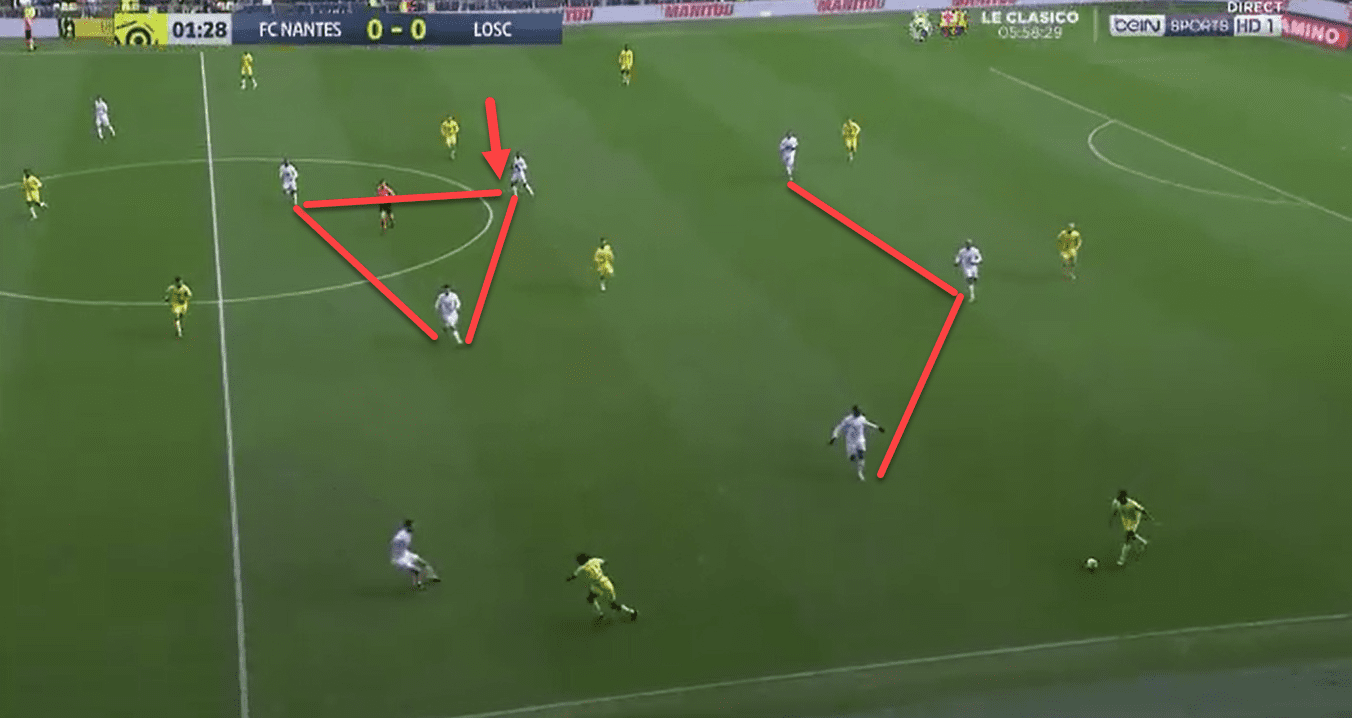
In addition to their press, Lille also sought to inject speed into the match through their offensive and defensive transitions. As follows, whenever they won the ball, Lille looked first to get in behind Nantes’ back four with direct passes. Notably, Lille gave less defensive responsibility to Ikoné than the rest of their midfielders, and he was permitted to shade higher when Nantes penetrated the Lille defence. This allowed Ikoné to save his energy for the attacking phases and also create a third outlet for Lille’s transition from defence to attack as demonstrated below.
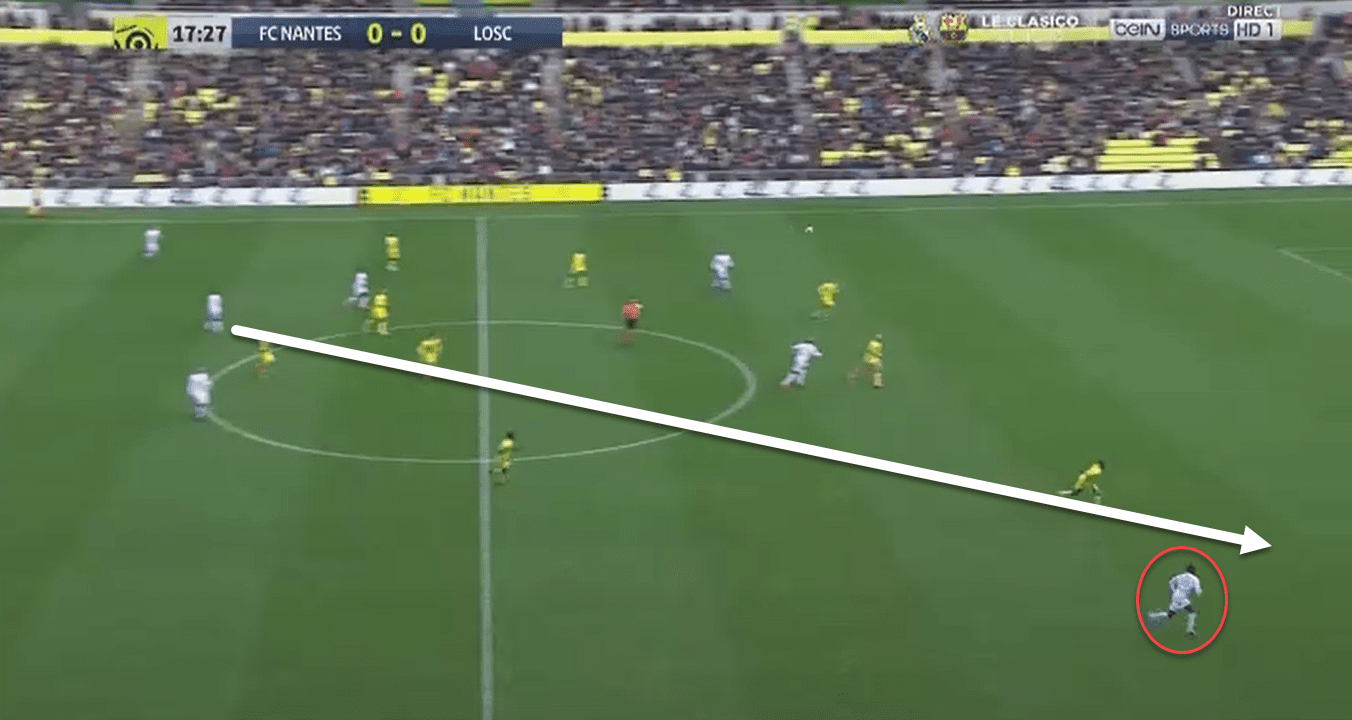
As they got forward, if Lille did concede possession, they would immediately counter-press the player on the ball. Key to this tactic is good support for the attack which allows players to be in position to press quickly. In the first half, in particular, Lille did a great job of quickly supporting their attacks. Consequently, when Nantes did regain possession, they were often swarmed as seen below.
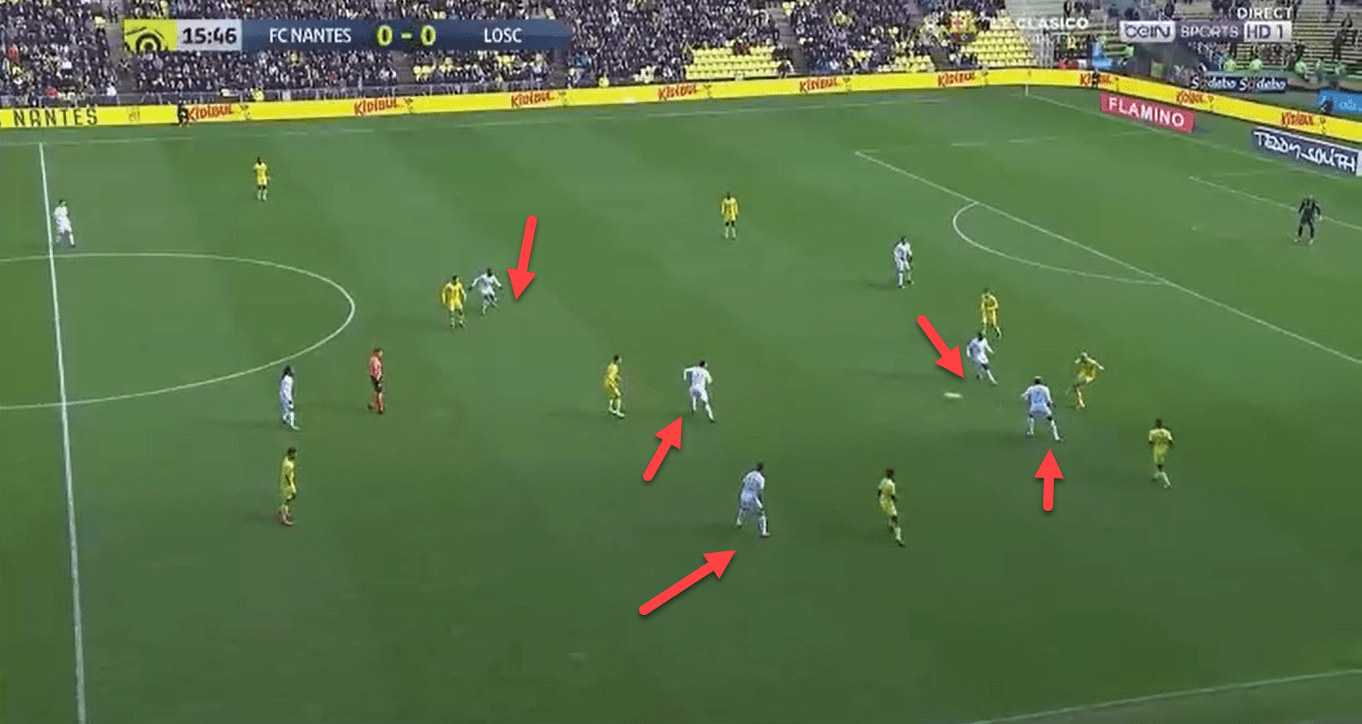
Lille’s attacking tactics
When it was not available for Lille to attack quickly upon winning possession, they would set up their attacking structure. They created this shape by having one central midfielder (typically Benjamin André) drift beside the line of pressure to create a three-man build-up, pushing their outside backs high, and inverting both their wingers as shown below.
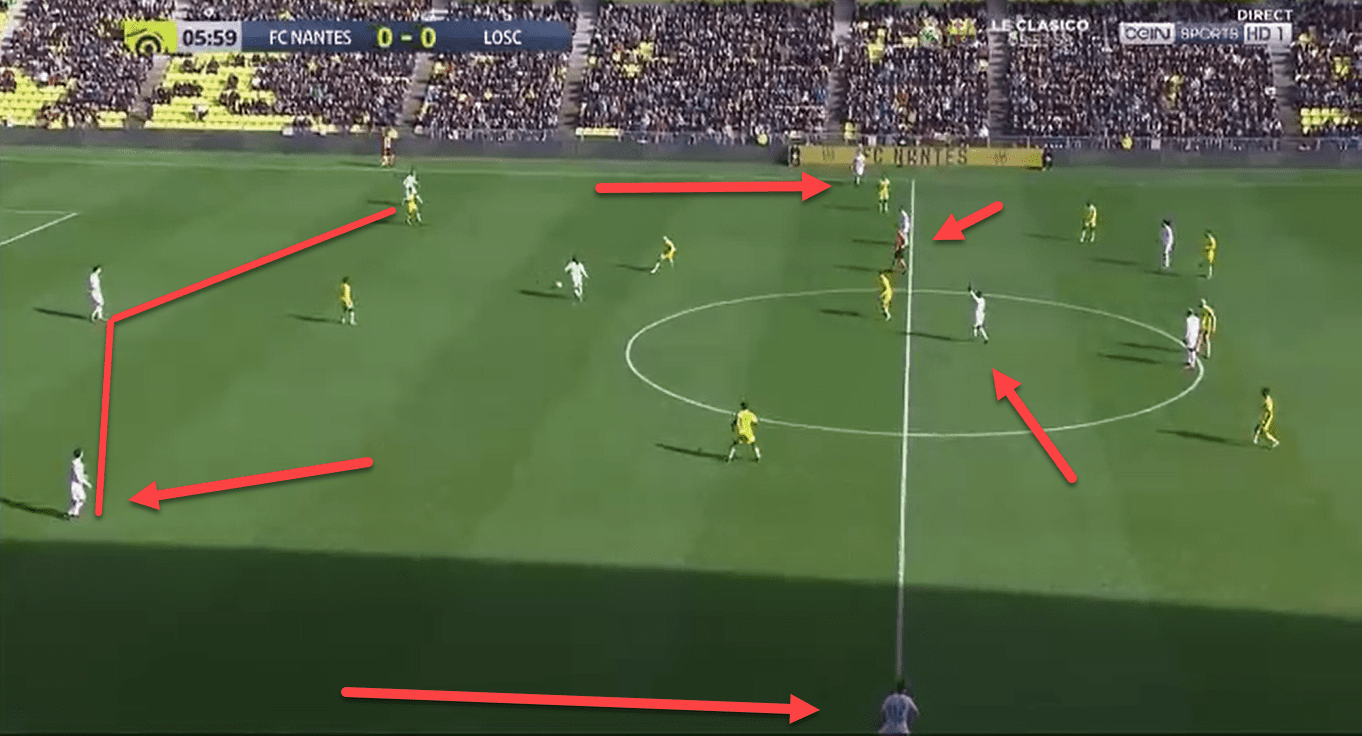
Although they created a new shape for the build-up, the main objective for Lille was still to play at a high tempo and get in behind Nantes. The brilliance of their attacking shape was that it gave Lille the ability to dominate possession while also giving them a threat in behind. Essential to this tactical flexibility was the positioning of Lille’s wingers. By having the wingers drift between the lines, the Nantes outside backs were forced into a no-win situation. If they stayed in their defensive block, they would leave the central midfielders out-numbered, and Lille would exploit their overload to penetrate through midfield. But if the outside backs stepped higher to limit Lille’s options in midfield, they would create space in the channels for Lille to play directly in behind for their pacey forwards to run 1v1 against Nantes’ less athletic centre-backs.
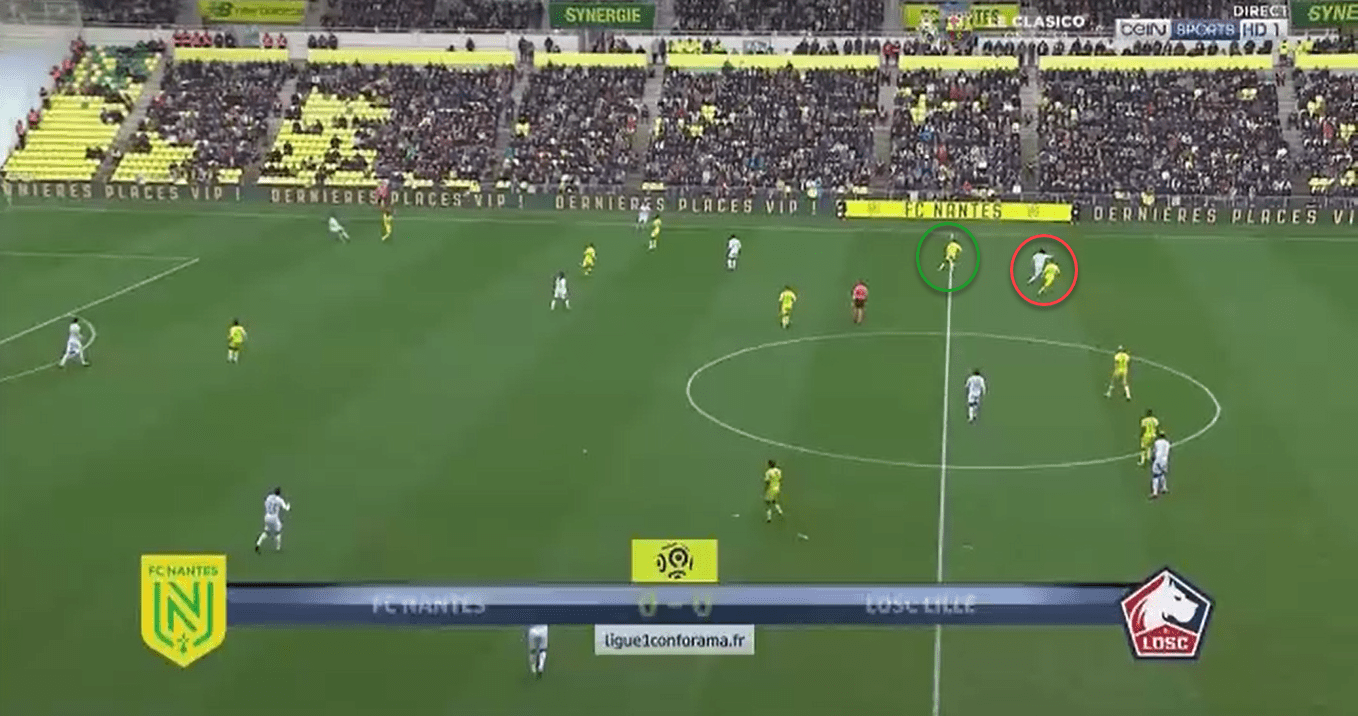
As Lille tried to build their attacks, at times Nantes were able to quickly press Lille’s centre-backs and prevent Lille from going forward. In these instances, rather than trying to use their one-man advantage in the build-up to break Nantes down through quick circulation of the ball, Lille preferred to pass back to their goalkeeper. As this happened, Lille would position the tall and aggressive Victor Osimhen near their right flank. Their goalkeeper would then play a long diagonal ball to Osimhen who would flick on for Ikoné as shown below.
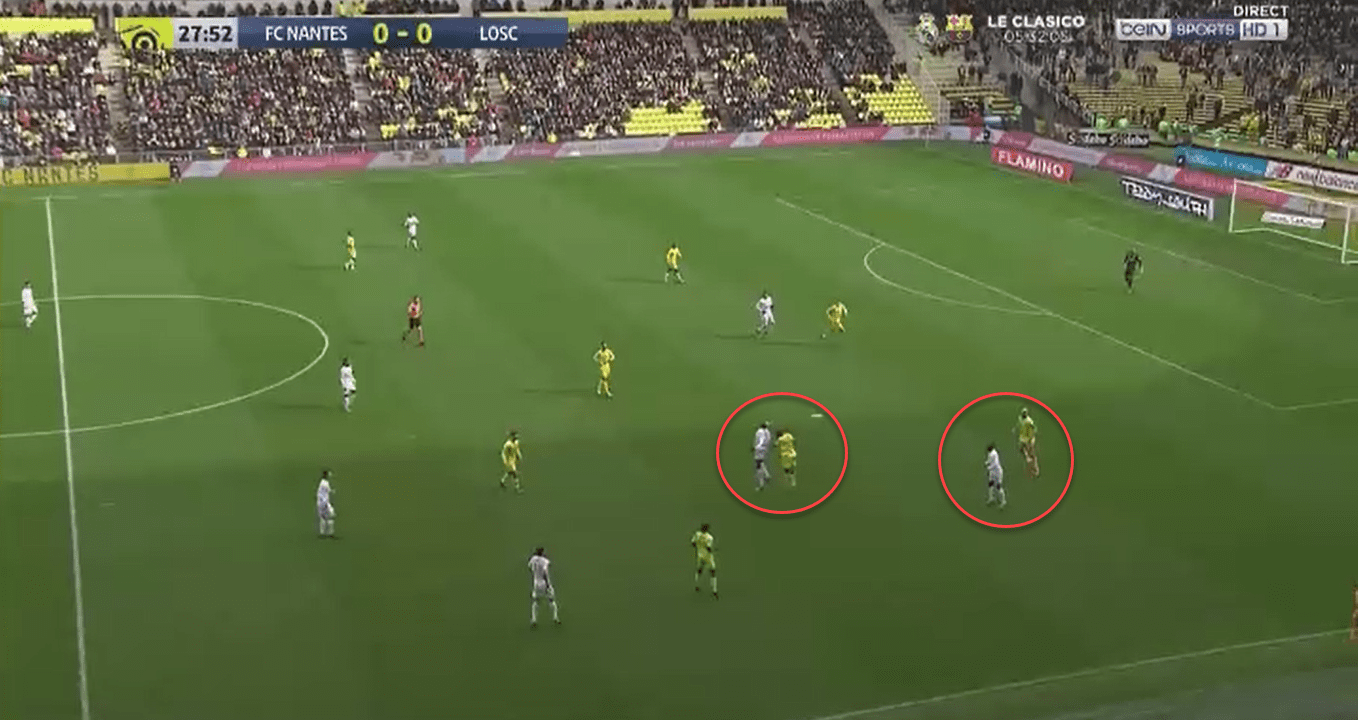
It’s important to note that whenever Lille would use this tactic, they opted to play the diagonal to the right side of the pitch. The reason for this was that if Lille could win the flick-on, which they usually did, Ikoné would be positioned 1v1 versus Nicolas Pallois. With the 32-year-old Pallois being the slowest of the Nantes defenders, this was an especially advantageous match-up for Lille. Therefore, on the many occasions in which Ikoné was able to gather the ball in the channel, he was often able to skate past Pallois and wreak havoc down the right flank.
Nantes’ errors
Although much credit should be given to Lille for their first-half dominance, their control of the match was also aided by Nantes’ tactical blunders. For starters, Nantes spent the majority of the game pressing 4-4-2 as shown below.
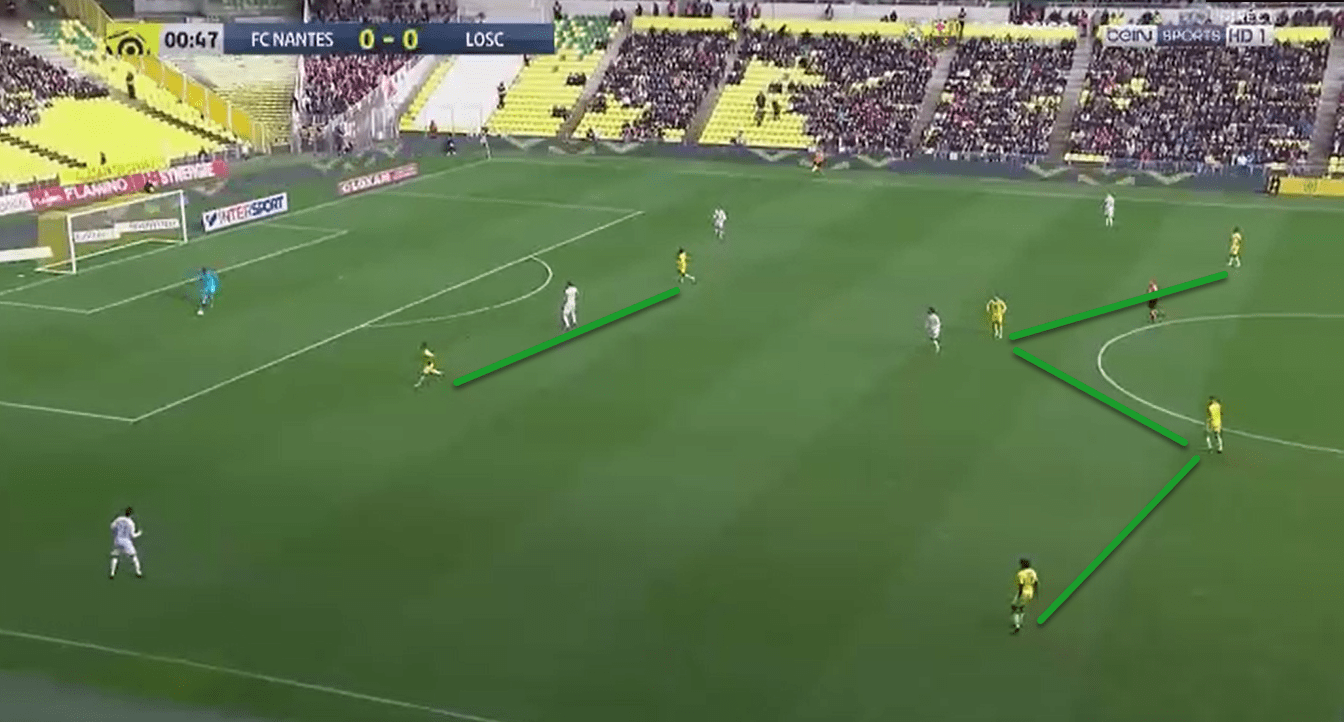
This was a poor decision for several reasons. First off, by pushing their line high, Nantes were playing directly into the hands of Lille by creating acres of space for Lille to run in behind. On top of that, Lille weren’t trying to build out of the back. As a result, by pushing numbers forward to press, Nantes were essentially leaving themselves short-handed for Lille’s direct play from their goalkeeper. What’s more, Lille’s forwards and wingers were significantly faster than Nantes’ defenders, and so pressing higher ultimately set the Nantes defenders up for failure. Rather than playing a high press, Nantes should have played a deeper block that limited the space in behind the backline and forced Lille to break them down.
Another tactical error made by Nantes was that they sought to keep their wingers wide when defending. The logic behind this was that when Nantes won possession, their wingers would be in position to counter into the space behind Lille’s high outside backs. Although sound in theory, the result of this tactic was that it left Nantes’ central midfielders isolated and out-numbered both defensively and in transition.
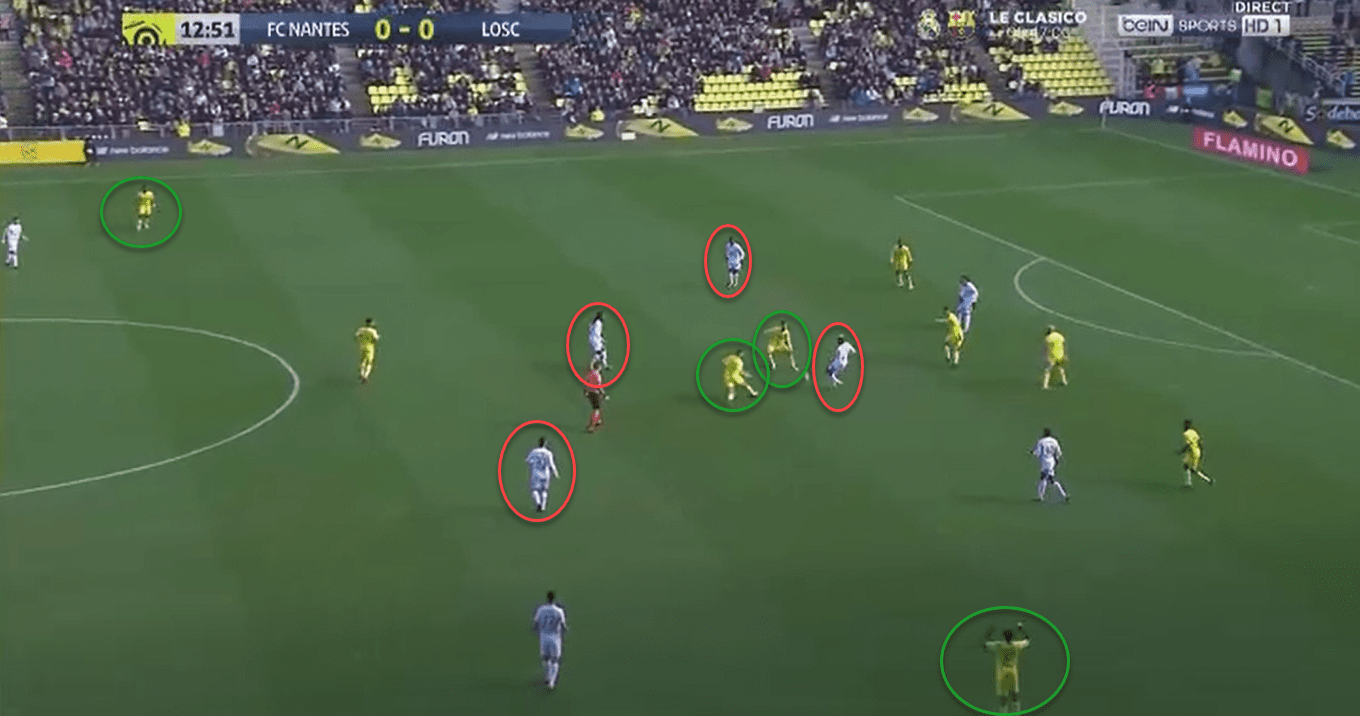
A final tactical error committed by Nantes in the first half was to play Moses Simon as a lone striker. Again, this tactic seemed logical in that Moses could perhaps use his electric pace to exploit the space in the channels behind Lille’s outside backs when Nantes won the ball. In practice, however, the tactic worked out poorly. Nantes were often pushed back by Lille’s direct play and then suffocated by Lille’s counter-press. As a result, Moses was left isolated near the halfway line, and when Nantes wanted to offer him service, they had to resort to hopeful long balls. With Moses being much smaller in stature than Gabriel and José Fonte, the Lille centre-backs dominated this match-up and Nantes were unable to generate many attacks.
Nantes recovery
The combination of Lille’s tactical genius and Nantes’ tactical naiveite saw Lille eventually break the deadlock inside the opening twenty minutes of the second half. But after this point, rather than continue their dominance, Lille’s control waned and Nantes finally got a foothold in the match. This happened for several reasons. First of all, Lille began to fatigue and could no longer meet the physical demands of their fast-paced brand of football. As a result, there was more time and space for Nantes to build attacks once they won the ball. On top of that, Nantes began winning more of the long diagonal balls that Lille’s goalkeeper played down Lille’s right flank, and this helped to keep Nantes from getting pinned back.
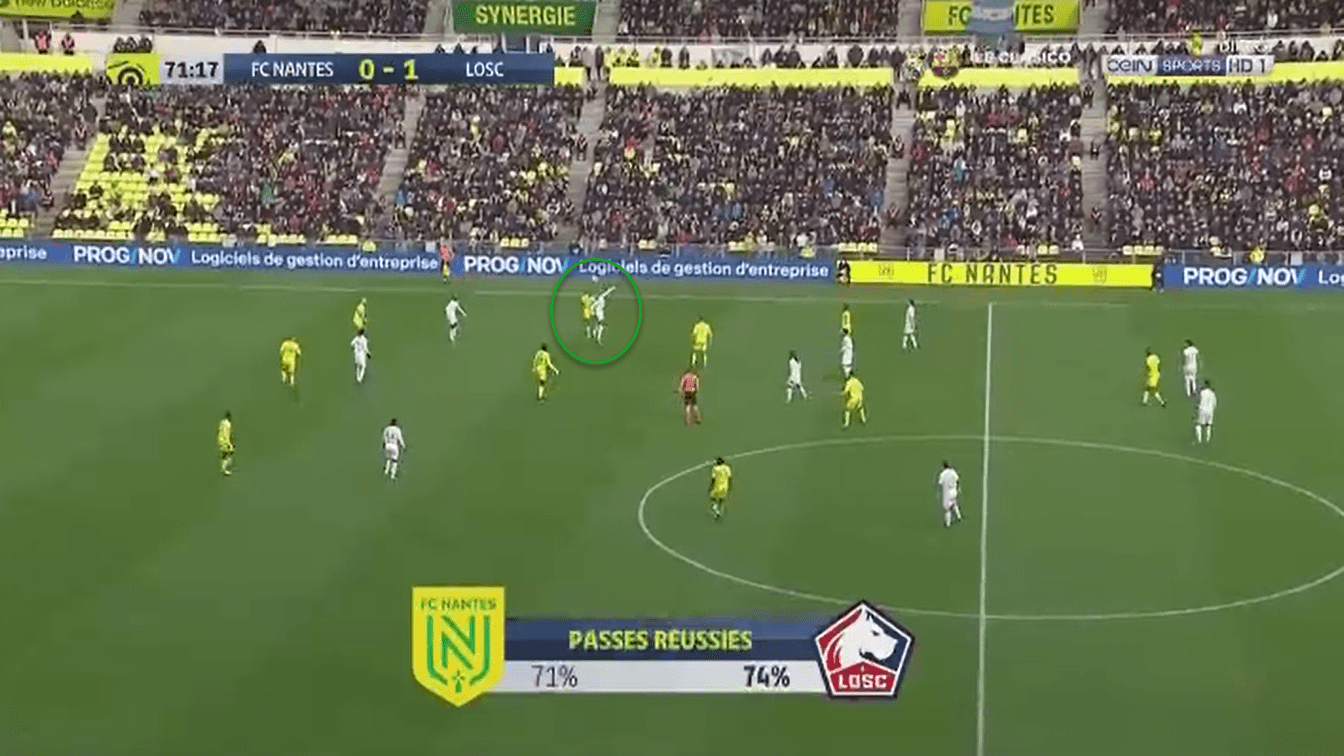
A further reason why Nantes grew into the game was the introduction of Kalifa Coulibaly. The Mali international was subbed into the game at centre forward, and Moses Simon was moved to the left-wing. This change benefited Nantes in two ways. For starters, it gave Nantes a much-needed physical presence up top who could hold the ball under pressure and help Nantes transition into the attack as shown below.
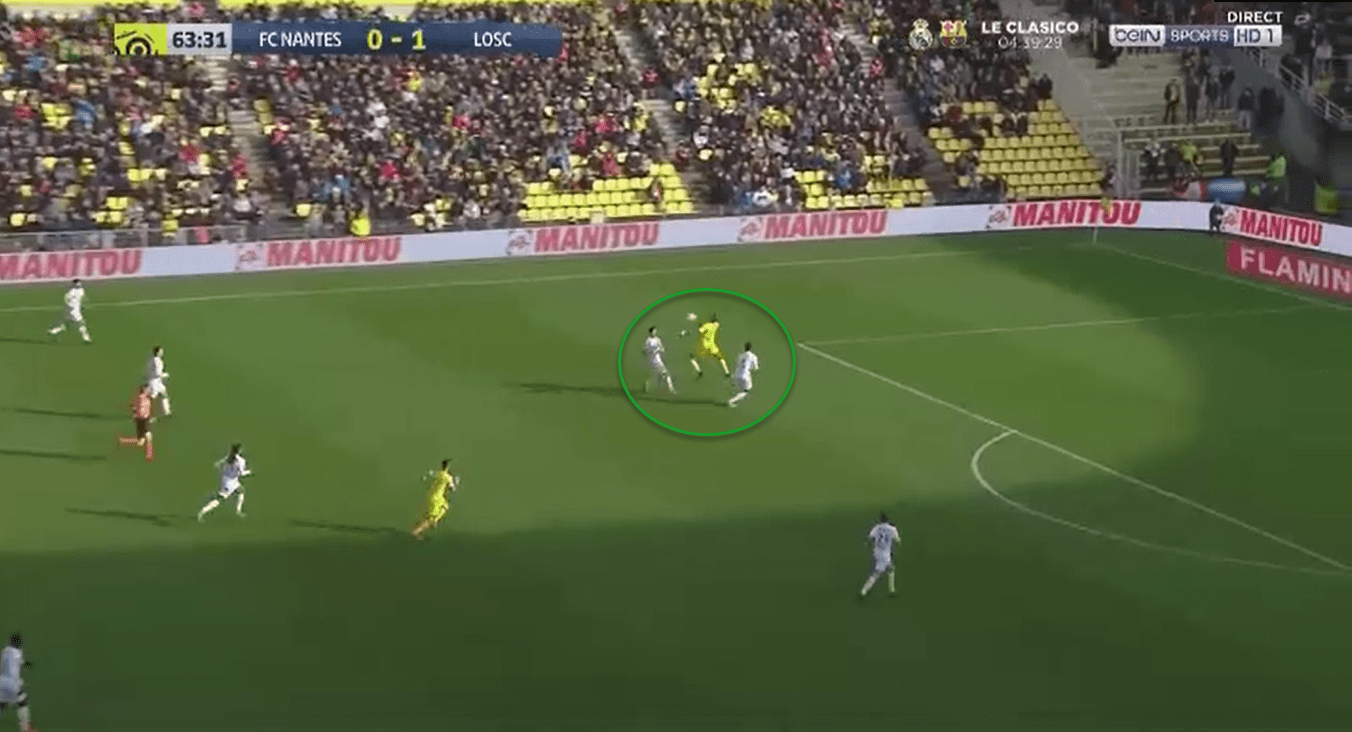
In addition, by positioning Simon on the left, he was able to receive the ball and run at defenders much more easily. And since Simon’s speed and trickery make him a mismatch for any defender 1v1, this required Ikoné to track back to help defend, effectively driving back Lille’s midfield and backline.
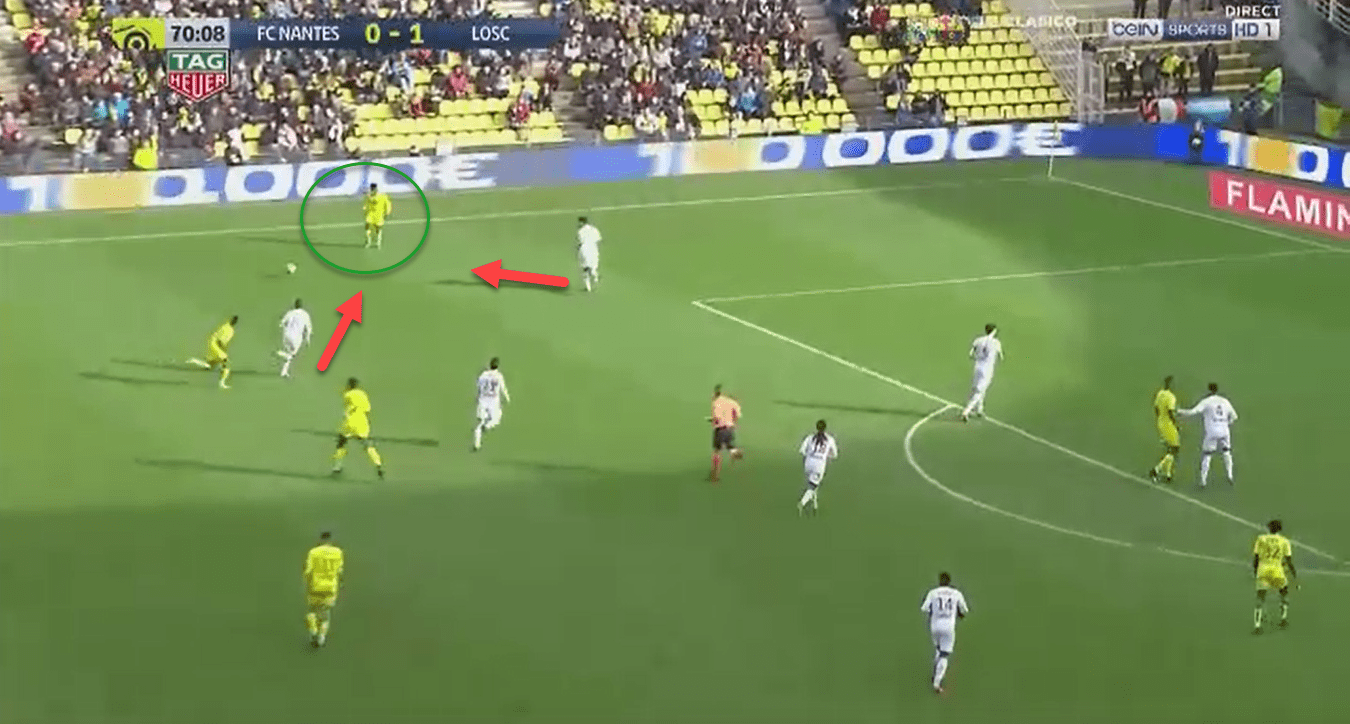
Although these changes helped relinquish Lille’s stranglehold on the match, outside of a corner kick that fell kindly to Nicolas Pallois, Nantes never truly threatened the Lille defence, and the score finished 1-0.
Conclusion
Overall, the match was an impressive performance by Lille as seen in how they crafted 13 key passes for an xG of 2.17 compared to Nantes who managed only five key passes for an xG of .38. With the victory, Lille are one point off Stade Rennais in the race for the final Champions League place, and it looks like Les Dogues could be heating up at just the right time.






Comments